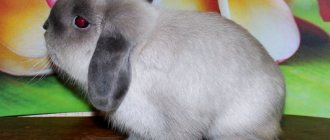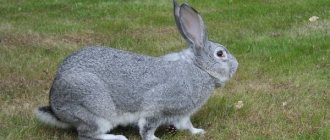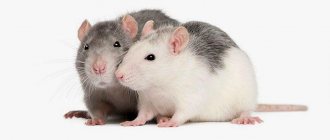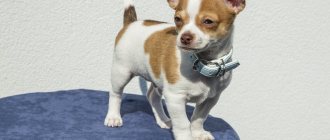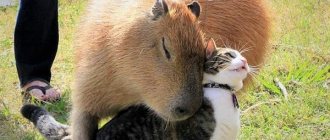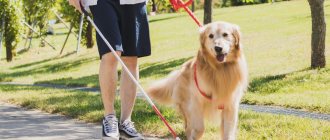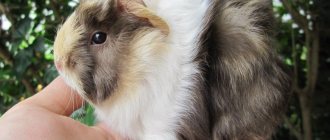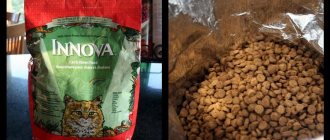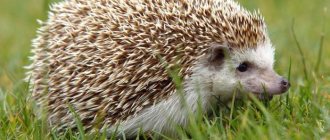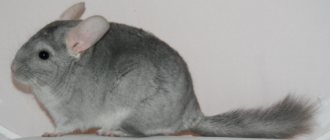Home » Interesting collections about cats and dogs
Huskies are one of the most popular dog breeds, but they have their own unique personalities. These companions can be destructive, especially when the owner is not around. For this reason, many people want to get a dog with a similar appearance. In addition, unscrupulous breeders sometimes sell mixed breeds and representatives of other breeds under the guise of huskies, so it is important to be able to distinguish related breeds.
- 2 Wolfhound of Saarloos
- 3 Alaskan Klee Kai
- 4 Czechoslovakian Wolfdog
- 5 Samoyed Laika
- 6 Tamaskan dog
- 7 Northern Inuit
- 8 Utonogan
Malamute
You can tell a malamute from a husky simply by their looks: the former look good-natured, while the latter are more reminiscent of mischievous foxes. The main difference is the eye color. If Huskies are usually blue, then Malamutes are always brown. Malamutes are denser in build and hardy. Their fur is darker and coarser. The tail is usually raised and slightly curled. Malamutes are slower, more reserved and calm, so they cause fewer problems, but they also need to be dealt with and allowed to splash out their energy.
Malamute is rather a cross between a wolf and a bear.
Why do huskies end up in shelters?
By visiting any of the sites that offer shelter dogs, you can see how common huskies are found there.
Most of them ended up in the shelter for a completely banal reason - they ran away from their owners. Some huskies manage to find new owners only in private homes, since “runaways” have an uncontrollable and freedom-loving disposition - walls, doors and furniture are not barriers for huskies. On their way they destroy everything.
There is a known case when it was necessary to take a photo of a one-year-old husky for an advertisement. The young dog tried to get out of the collar and wanted to run away, despite the good attitude of the owners. I had to pull the leash tight and secure the dog so that he wouldn’t move for at least a couple of seconds. This is a small example of the wild, freedom-loving and rebellious spirit of the husky, which is to the taste of few.
And although breeders are aware of the complex nature of huskies, they still “disappoint” their owners and end up in shelters. Looks like fashion is to blame.
We also recommend reading:
I would never have thought that I would have a dog, because I am a cat lover, a poultry farmer, a fish farmer and a rat breeder (true story) 10 puppies is not the limit! Chihuahua Lol was included in the Guinness Book of Records Top 10 strongest jaws on the planet Vasya: an unusual cat who came into the family on his own (a real story from a reader)
Wolfdog of Saarloos
The ancestors of the Saarloos wolfdog are German shepherds and wolves. This is an unusually intelligent companion that becomes strongly attached to its owners. However, high intelligence can also be considered a disadvantage: these dogs can try to dominate their owners, so they are not suitable for beginners. Due to their independence, representatives of the breeds are often used as rescuers and guide dogs.
An interesting feature: Saarloos dogs cannot bark, they only howl like wolves
How to choose a puppy
The character and individual characteristics of the breed appear at 4 months of age. It is at this time that it is recommended to buy pets.
It is almost impossible to choose the best puppy, as they change as they grow. If the goal is to buy a husky to participate in exhibitions, only experienced dog breeders can help in choosing.
Advantages of buying a Husky puppy and care details:
- the baby will easily adapt to the lifestyle of his owners;
- increased attention to yourself will allow you to better know his inner world;
- Husky puppies quickly learn the rules of behavior;
- Babies require increased attention and you need to spend a lot of time playing with them.
If you buy an adult dog, then this moment has its advantages:
- established character;
- trained in rules of conduct;
- surprises in terms of interior damage are excluded.
The cost of puppies depends on how purebred the husky is. Purchasing purposes also influence the price.
- Pet - class is not suitable for participation in exhibitions, but will be a good friend. Such dogs are sold without a pedigree and have some distinctive characteristics from the breed standard. Puppies cost from 20,000 rubles.
- Breed class puppies are sold with good pedigree and fully comply with the standard. The price starts from 30,000 rubles.
- Show class is the most expensive. The starting price for show-class huskies is 50,000 rubles. Puppies have high characteristics, both in appearance and in the achievements of their parents. The sale of such puppies begins at 6 months of age; only during this period can the dog’s compliance with all standards be fully confirmed.
In any case, no matter what class of puppy you buy, he will turn out to be a good friend and companion with whom you are not afraid to go on a trip.
Alaskan Klee Kai
These dogs are often called a miniature version of a husky. In fact, this is so: the ancestor of the family was, presumably, a husky with the dwarfism gene, which they decided to fix. However, there is controversy over the nature of the dogs. Most owners claim that the Alaskan Klee Kai is a more balanced and calm breed. These pets also do not tolerate loneliness very well, but are less prone to running away and destructive behavior. Unfortunately, this is a rare breed, so the average cost of puppies is 100,000–150,000 rubles.
Representatives of the breed have a cute habit of washing themselves with their paws, just like cats do.
Origin story
The Siberian Husky has been living with humans for several centuries. Bred in cold climatic conditions in the Far North. Local residents needed a dog that could easily cover long distances and transport people and cargo. The formation of the husky's character was greatly influenced by regional climate conditions with fairly low temperatures. Under their influence, the structure of the animal was formed.
Since the 20th century, there has been an active spread of the breed throughout the world. Residents of the American continent appreciated such qualities of their four-legged friend as agility and the ability to walk smoothly in a harness.
Alaskan mushers needed dogs for sled dog racing. The legendary husky Togo, in the team of Leonard Seppala, did not give up the championship for many years in a row. However, he gained fame for completely different merits.
In 1925, a dog relay race was held, during which Leonard Seppala's team, led by Togo, covered a long section of the route and reached a small town in Alaska. The inhabitants of Nome were exposed to a fatal disease, and the dog Togo, with other dogs in the sled, delivered them anti-diphtheria serum. Thanks to him, residents received a chance for recovery.
At that time, getting to the small town was completely problematic, since natural conditions did not allow it. The leader of the pack with his faithful dogs covered 146 km of the road, 80 km of which they walked on the ice of Norton Bay in severe frost conditions of -400, with a strong snowstorm. Togo's endurance, courage, and instincts helped the team reach the town of Noma and help people.
Since huskies were sled dogs, their further selection was carried out in America; in our country, sled dogs were considered unpromising.
In the USA, as a result of crossing aboriginal sled dogs with huskies, mixed breed pets appeared that outperformed huskies in racing competitions. However, the developed dog breed was not recognized by international organizations, since the varieties were of different types.
In the 70s, the breed was presented at exhibitions. L.Demidoff and E.Sili convinced people that a bright dog with blue eyes is suitable for keeping in an apartment, as it is a companion dog.
In the 90s, the husky returned to Russia, its historical homeland. In 1995, the first dogs were brought from the Czech Republic and Belgium. By 2000, the number of husky puppies increased to 150 individuals.
Czechoslovakian Wolfdog
The Czechoslovakian Wolfdog is another cross between a German Shepherd and a wolf. Another name for the breed is wolfdog. Color varies from gray to reddish. Externally, representatives of the breed really resemble wolves. The owners note that these are very loyal and friendly dogs, but they need proper socialization. Otherwise, “wild” habits take over.
The Czechoslovakian Wolfdog appeared relatively recently - the breed was recognized by the FCI in 1999
Age of change
The beginning of the twentieth century was a turning point in the history of the breed. Soviet dog handlers decided that this dog was too small for cargo transportation, and therefore useless. She lost her breed status and breeding was prohibited. A new round of development of the breed occurred thanks to the Americans. Around 1930, the Alaska Gold Rush began and several teams of huskies were taken there. It was here that sled dogs showed themselves in all their glory. The path to the mines was not close, but with such partners it became much more fun.
Huskies began to rapidly gain popularity and participate in a variety of exhibitions and competitions. Around this time, representatives of the glorious breed even became national heroes, fighting their way through a snowstorm with a load of medicine for the city. The Husky dogs shone again. Photos of hero dogs were seen by the whole world.
Samoyed husky
The Samoyed husky looks less like a husky, but it looks like a snow-white wolf. Most representatives of the breed boast a fluffy white coat. However, it requires intensive care, otherwise the fur may become tangled. These are beautiful dogs, but they are not suitable for beginners due to their stubborn and capricious nature.
Cream spots, cream coloring and freckles on the nose are acceptable in the color of the Samoyed dog, and the first four generations of breeding of these dogs were completely black
Summary table: common and different between breeds
| Characteristic | Husky | Malamute | Laika | Samoyed | Mini kli-kly | Akita Inu |
| Size | 54–60 cm | 59–64 cm | 55–59 cm | 53–57 cm | 38–43 cm | 61–67 cm |
| Weight | 20–27 kg | 34–39 kg | 18–25 kg | 17–26 kg | 6–10 kg | 30–45 kg |
| Head | The width of the muzzle is average, the skull is quite dense | Wide and powerful, the muzzle is slightly shorter than that of a husky | Elongated muzzle (narrower than a husky) | Triangular muzzle with a large fleshy nose, almond-shaped eyes | Wedge-shaped, tapering towards the tip | The muzzle is narrow, the skull is rounded; there are characteristic skin folds in the cheek area |
| Body | Strong with well-developed muscles | Stocky and muscular | Compact and thinner than a husky | More graceful than a husky | Dense and strong for its size | Stocky and muscular |
| Tail | Low set, lowered down or standing in a semi-circle above the back | Medium set, most often the dog holds it above the back in a semi-ring | Medium set, most often the dog holds it above the back in a semi-ring | Set high, the dog holds it thrown over its back or side | Covered with thick fur, lies on the back or side of the dog | Set high and curved into a donut, lying on the back or side |
| Wool | Medium length, quite soft, with pronounced undercoat | Medium length with a very dense but harsh undercoat | Medium length, soft | Thick, soft, long | Medium length, quite soft, with pronounced undercoat | Short but soft, has a thick undercoat |
| Color | Any | Any spotted color, the only acceptable solid color is white | Any spotted color | Solid white only | White-black, white-gray, white-red, black-white-red | Red and white, brindle and pure white |
| Lifespan | 13–15 years old | 9–10 years | 13–15 years old | 13–15 years old | 14–16 years old | 10–12 years |
| Activity | Very high | High | Average | Average | Average | Moderate |
| Training | Requires patience and a lot of time due to the stubbornness and restlessness of the dog | The dog is smart, but difficult to train | Quickly learns commands, willingly obeys a person | Easy to train, obedient dog, but can be stubborn | Easy to learn | Requires patience and a lot of time due to the stubbornness of the dog |
| Aggressiveness | Overall the dog is considered friendly | Aggressive towards other animals | Friendly to both people and animals, as long as they do not threaten the dog or its owner | Friendly to people and large animals, but small animals can be perceived as prey | Not prone to causeless aggression | Aggressive towards strangers and other animals |
Huskies are easily confused with other members of the Spitz family. There are similar ones among the experimental hybrids of domestic dogs and wild wolves. But it is worth remembering that all dogs have their own character traits. They must be carefully studied so that problems with the pet do not arise later.
Tamaskan dog
The Tamaskan dog was developed in Finland. It is the result of crossing a Malamute, a Husky and a German Shepherd. The result is family companions that enjoy playing with other pets and children, but look like real wolves. These pets can be very large: weight reaches 40–45 kg.
They need constant physical activity and long walks.
Aries - Alabai
A true comrade in arms: he won’t let the enemy near, and will hide behind his partner’s back only to suddenly jump out at the right moment and bite everyone. A dog full of strength, courage and self-esteem. And truly asinine stubbornness: if an alabai decides something, then so be it. Those who want to argue must first move seventy kilograms of Alabai flesh, from the tip of the fang to the tip of the tail, created specifically to crush ferocious wolves. So you're saying there are no takers? Hm. Alabai thought so. The Aries young lady too.
Northern Inuit
The Northern Inuit is a breed that is still not recognized by the FCI. Outwardly, it is a cross between a Samoyed husky, a husky and a wolf. There are even Inuit with a white coat. Unlike Samoyeds, they look less plush.
Northern Inuit dogs played direwolves in the Game of Thrones series, based on the A Song of Ice and Fire book series by George R. R. Martin
Are there other types
The Siberian Husky is a world-famous sledding breed, whose “services” are used by the peoples of the Far East. The average weight of the animal is 15-28 kg, height at the withers is 50-60 cm.
It is believed that huskies originated from the inhabitants of Kolyma, Kamchatka, and Anadyr. Dogs of this breed appeared in North America at the beginning of the 20th century, where they were officially registered.
Fans of Siberian Huskies are attracted by the animal’s elegant coat color, thick fur and expressive blue eyes.
Similar traits can be found in representatives of breeds similar to husky. This is interesting! Huskies are considered one of the most common breeds found in homeless animal shelters. This is because not everyone can cope with their character.
Australian Shepherd (Aussie)
Representatives of this breed have the same blue eyes as huskies. The personality traits of the Aussie allow even beginners to own this dog. Aussies were previously used in America as herding dogs, which reflected their extraordinary intelligence, desire to learn new things, and ability to pick up everything on the fly. The Australian Shepherd is known for its good-natured, easy-going, positive and cheerful character. She won't let you get bored. Some individuals are capricious and cunning
It is important to show character and not be led
During training, manifestations of aggression, poor handling or running away for adventure are excluded. After all, the character of a shepherd dog is genetically based on the desire to “herd” its beloved owner and members of his family. This breed, compared to the husky, will suit many people not only because of its beautiful eyes and funny face.
The fact is that the Australian Shepherd is easy to train and raise. She will become a family pet, a companion dog and an active energizer with an easy-going character.
If you love the animal, take timely walks and pay attention, the Aussie will never run away, and the apartment will always be in order.
I would like to end my short story on this positive point. There is no need to rush when planning to get a Husky. It is quite possible that it is worth choosing one of these options, which has a more accommodating character and has much in common with the husky breed.
Nuances of breeding
The crossing of a dog and a wolf in the wild happens quite rarely, and this fact could not but arouse interest among scientists. Most often this happens in areas where the number of wolves is small, and also if she-wolves are left without a mate. In other cases, wild animals pose a danger even to large dogs.
If we are talking about breeds that simply look like wolves, their breeding does not differ in any particular way. As for crossing, certain difficulties may arise here. Due to genetic displacement, it is not uncommon for only 1-2 puppies from a litter to be considered a successful crossbreed. Congenital anomalies of physical development occur, for example, when the skeleton and ligament system are inherited from different parents.
Another problem with such crossbreeds is the bite. Its fault, as in the previous case, is the difference between the types of parents. Pathologies may be incompatible with life, then the puppies are simply euthanized. In cases where the indicators are within normal limits, and the character and instincts do not inspire fear in researchers, the animal is provided with the necessary conditions of detention.
One cannot ignore the problem that arises when breeding crosses between a dog and a wolf, such as mental imbalance. The pack instinct is very pronounced, as a result of which the animal will fight for its place more actively than an ordinary dog and can use various, sometimes even harsh, methods for this.
When puppies appear that meet the requirements of breeders, you need to remember about their mandatory, as early as possible socialization. Literally in the first minutes of life they must get to know a person. Experts also recommend not depriving children of the company of puppies of ordinary dog breeds. Socialization is a long process and must be maintained throughout the animal’s life. However, wolf genes still will not allow making a mestizo absolutely soft and good-natured.
See the following video about the characteristics of the breed.
Purpose
Huskies can be used as a sled dog and as a companion. Many fanciers get several dogs of this breed at once in order to form a full-fledged team for participation in competitions.
But even one husky dog can keep you company on a hike in the mountains or on a winter ski trip. Thanks to her goodwill and charm, the ability to make independent decisions in a difficult situation and high intelligence, the husky has become an excellent pet.
Does it apply to riders?
The large snow-covered expanses of Siberia, where frosts are off the charts, and sparsely populated areas have created a need for such a dog. A strong, devoted and reliable assistant who will help, understand, support and save in the incredibly difficult living conditions of humans in the northern regions. The Chukchi were able to train this animal to Husky, hence the name of the Eskie breed from the American Husky.
This and only this was its main purpose. Transport cargo over vast distances, despite the cold and raging snowstorms.
The Americans appreciated this breed of sled dogs, took them to Alaska and placed them on a podium and turned them into a national treasure of America. And she deserves it, and so that they don’t forget where she came from, they called her Siberian.
During the “gold rush” in the 30s, this dog, so similar to a wolf and so friendly to humans, could not help but arouse admiration, steadfastly enduring, together with humans, all the hardships and hardships of camp life in the harsh climate of the Far North.
Eskimo sled dogs have long been bred to help people who fished and hunted. Usually, for a good team, at least 9 dogs were used, and they were fed dried fish. Dogs were never divided into the categories of sled dogs, hunting dogs, or reindeer dogs and were used as universal dogs.
Popular Articles Old English Bulldog (Reinvented): Back to Basics
Hunting breed or not?
Feeding northern aboriginal dogs still retains its unusual nature. The animals feed by hunting; as soon as the snow melts, the team is released into the wild. Thanks to this, all such dogs have a highly developed hunting instinct, but whether they are suitable for hunting is a somewhat controversial issue. And although it is, of course, possible to interest them, and the dogs hunt, they will not bring prey to the owner.
Their diet includes field mice, small birds, and sometimes a Husky can catch up with a hare and tear it to pieces. And if Huskies unite in a pack, they can drag away a goat.
Such hunting instincts often lead to dogs, as predators, attacking cats and killing them, although if they grew up with cats in the house, they do not touch them. This feature of Husky behavior often leads to conflicts with neighbors.
Is it suitable as a security guard for a private home?
Watchdog and security qualities are completely absent from these dogs. Too friendly, showing incredible sympathy, without obvious aggression towards strangers. And a Husky will not be a watchman, since they do not have the instinct to protect their territory. For protection, it is better to choose another breed.
Can he be a defender?
An ordinary Siberian Husky cannot be a protector of the home and owner, unless it is a breed bred in Japan (Akita Inu).
Breeding for sport
Siberian Huskies have had high driving qualities for many years, but time does not stand still. And to breed dogs with higher racing speeds, mixed breeds appeared. There was a mixing of various breeds of hounds and pointing breeds with purebred Huskies.
The resulting dog breeds led to the fact that, while maintaining the advantages of this dog breed, they showed much greater speed as sled dogs in sports. Purebred Huskies still participate in sports races, but they lose greatly to mixed breeds - Alaskan Huskies. The Alaskan Husky is an athletic, very fast and resilient dog.
Husky mixes that may be similar to the original
Common husky analogue mestizos are represented by a mixture of:
- with Alabai - dogs have larger sizes and a stronger build;
- with a German shepherd - the cross has received many names: husky shepherd, Gerberian Shepski, Siberian shepherd and German husky;
- with a husky - a mestizo has the appearance of one of the parents, and the character of the other, the exterior depends on the variety of the northern breed;
- with a Malamute - the kids resemble both breeds at the same time, the average height ranges from 56 to 58 cm.
Important! Mixtures can be of any color - reddish, grayish, white, brown, medium-sized or large. Indicators depend on the second parent.
Sled breeds that have not received recognition, mixed, developing.
Having dealt with the breeds included in the FCI documents, we cannot help but say about those that are not yet officially recognized, but have brilliant prospects in this regard.
Alaskan Husky
Indigenous representatives of the aboriginal fauna with “wild” ancestors. They differ from their Siberian relatives in character and smaller dimensions. The breed was formed naturally, without human intervention. The dogs turned out to be strong, hardy, and also unpretentious, because individuals with poor health and constitution died in harsh climates. Today, Alaskan huskies are considered perhaps the fastest sled dogs. Despite the temporary lack of official status, the breed is very popular in the United States.
The Alaskan Husky resembles its Siberian counterparts in appearance.
Sakhalin Husky (Karafuto-Ken, also known as Gilyak Laika)
This domestic variety of mounts, which, oddly enough, is popularized by Japanese cynologists, was created for use for transport purposes, but thanks to courage and fearlessness, they began to be used by hunters for hunting animals.
If not for the donut tail, it would be an almost white wolf
Chinook (Chinook sled dog)
Representatives of this breed are large dogs (up to 45 kg in weight and up to 75 cm in height). They have well-developed bones and muscles, excellent health, and a calm temperament. Chinooks are used for riding and transporting goods, and in terms of running speed they are only slightly inferior to the recognized champions - huskies. If you keep a dog properly and raise it correctly, you can grow it into a friend and a guard, so docile and versatile are the representatives of this breed.
Hardworking Chinooks
Norwegian sporting mixed breeds (Greysters)
Dogs of a special breed, in the formation of which German shorthaired pointers and pointers, as well as greyhounds, took part. Mestizos were bred exclusively to participate in racing competitions. The animals performed well in competitions in skijoring (cross-country skiing) and bikejoring (towing mountain bikes).
Popular articles Alaskan Malamute (photo): an impressive dog for active families
The winning team
Wolfdog
This is the name given to mixed breeds obtained from the mating of a German shepherd and a wild wolf. They are used as mounts and guards. The first generations of puppies were distinguished by an unstable psyche and corresponding behavior. Breeding wolf-dogs is an attempt by domestic biologists to create a dog with universal service characteristics. However, most of the offspring remained in the ownership of the breeders. Some individuals were rented (not sold!) for official purposes.
This is what a wolfdog looks like - a service dog of wolf origin
Wolf dogs during the race
Eskimo Husky
One of the varieties of northern sled dogs. Representatives of the breed are strong, hardy, and almost never bark. The homeland of the Eskimo husky is Eastern Siberia. In the 20th century, dogs became popular in Alaska and Greenland. Nature has endowed these dogs with a stern character and courage, so the “Eskimo” can not only transport cargo, but is also an excellent watchman, as well as a reliable hunting assistant.
Eskimo Husky
Yakut Laika
An old breed of dog from Northeast Russia. Yakut dogs are universal. Like some other sledding breeds, they cope with transport tasks, and also have hunting and guard qualities. Yakut Laikas are distinguished by their sharp mind and sociable character, they sincerely become attached to a person and serve him with great diligence.
The Yakut Laika is not afraid of harsh winters
This is not a complete list of sled dogs, whose working abilities people have long appreciated and successfully use. Despite the fact that the dogs are not yet recognized by the Fédération Cynologique Internationale, many breeders and dog handlers believe that it is just a matter of time.
Team of Yakut Laikas
Utonogan
The Utonogan is another cross between a Malamute, a Husky and a German Shepherd, but is fluffier. This breed was bred for street living. They are excellent guards. A thick undercoat protects them from the cold.
It is worth noting that ducklings are famous for their voracious appetite; you will have to carefully monitor your pet’s diet to prevent obesity
It turns out that the husky has a lot of relatives who look like him. These are dogs of different weight categories, colors and with different characters, so everyone can choose a companion. For lovers of miniature pets, the Alaskan Klee Kai is suitable, and those who prefer more powerful pets should pay attention to the “wolf” breeds.
Sources:
https://prohvost.club/sobaki/porody-sobak/sobaki-pohozhie-na-haski.html https://gafki.ru/sobaki/pokhozhie-na-khaski.html https://kot-pes.com/ dog-pohozhie-na-haski/
Common Animal Traits
Dogs, which are very similar to wolves, share common features with these animals. First of all, we are talking about appearance. However, other features may also appear. When it comes to hybrids, it must be taken into account that they need the earliest possible socialization and education.
Such dogs, like their wild relatives, are prone to barking and howling. They cannot stand loneliness. At home, these animals, yearning for their owner, can cause significant damage to property, ruin furniture, clothes and shoes.
Both species of these animals molt 2 times a year. If you keep your dog at home, this factor can be very unpleasant. To minimize the consequences, the dog should be brushed regularly and the rooms should be cleaned. However, the best option would be to keep it outside, where the dog will feel especially comfortable.

